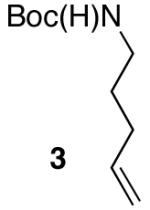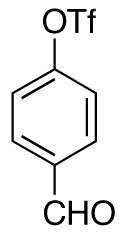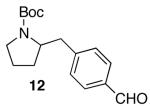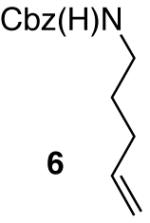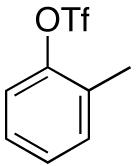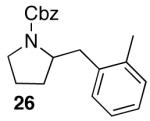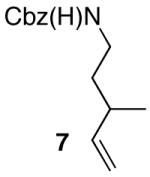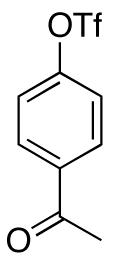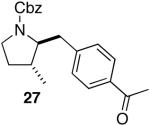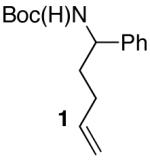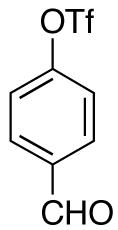Abstract

The palladium-catalyzed carboamination of N-protected γ-aminoalkenes with aryl bromides and -triflates has been achieved under new, mild reaction conditions using the weak base Cs2CO3 in dioxane solvent. These reactions tolerate a wide variety of functional groups, including enolizable ketones, nitro groups, methyl esters, and acetates, which are not compatible with previously described conditions.
The development of synthetic methods for the construction of substituted pyrrolidines has been of longstanding importance in organic chemistry due to the prevalence of this moiety in biologically active molecules and natural products.1 Over the past several years, the palladium-catalyzed carboamination of γ-aminoalkenes with aryl bromides has emerged as an efficient and stereoselective method for the construction of substituted pyrrolidine derivatives.2,3 These transformations effect tandem cyclization and coupling in a process that generates a C—N bond, a C—C bond, and up to two stereocenters in one step. For example, treatment of Boc-protected amine 1with 4-bromoanisole in the presence of NaOtBu and catalytic amounts of Pd2(dba)3 and dppb afforded pyrrolidine 2 in 60% yield with >20:1 dr (eq 1).2c
 |
Despite the synthetic utility of these transformations, the reactions are typically conducted in the presence of the strong base NaOtBu, which limits the scope of this method. For example, the use of NaOtBu restricts the functional group tolerance of these reactions, and transformations of aryl triflate electrophiles, which decompose in the presence of strong base, have not been reported. Additionally, Cbz protecting groups, which are frequently employed in the synthesis of complex alkaloids, are incompatible with the strongly basic conditions. In this Letter we describe the development of new conditions that replace NaOtBu with weaker bases (Cs2CO3 or K3PO4), which significantly expands the scope of the carboamination method.
In our preliminary studies on palladium-catalyzed carboamination reactions of γ-(N-Boc-amino)- or γ-(N-acylamino)alkenes, our attempts to conduct the transformations using bases other than NaOtBu were met with limited success.2c For example, the Pd2(dba)3/Dpe-phos4 catalyzed carboamination of 3 with 4-bromo-tert-butylbenzene afforded 4 in 81% yield when the reaction was conducted in toluene solvent with NaOtBu as base (Table 1, entry 1). However, use of Cs2CO3 in place of NaOtBu provided only a 38% isolated yield of 4, and led to the formation of large amounts of side products (entry 2).5,6.
Table 1.
Optimization Summarya
 | ||||
|---|---|---|---|---|
| entry | base | “Pd” | solvent | yield |
| 1 | NaOtBu | Pd2(dba)3 | Toluene | 81% |
| 2 | Cs2CO3 | Pd2(dba)3 | Toluene | 38% |
| 3 | Cs2CO3 | Pd(OAc)2 | Toluene | 63% |
| 4 | Cs2CO3 | Pd(OAc)2 | Dioxane | 82%b |
Conditions: 1.0 equiv substrate, 1.2 equiv ArBr, 2.3 equiv base, 1 mol % Pd2(dba)3 (2 mol % Pd) or 2 mol % Pd(OAc)2, 2 mol % Dpe-phos (with Pd2(dba)3) or 4 mol % Dpe-Phos (with Pd(OAc)2), solvent (0.25 M), 105 °C.
The reaction was conducted at 100 °C.
To improve the yields obtained in Pd-catalyzed carboamination reactions that employ mild bases, the effect of palladium source and solvent were systematically examined; the key results of these studies are summarized in Table 1. After some experimentation, it was discovered that use of Pd(OAc)2 in place of Pd2(dba)3 leads to significantly improved yields of 4 (63%, entry 3), and replacement of toluene with dioxane as solvent provides optimal results (82%, entry 4).7,8
As shown in Table 2, the new reaction conditions described above are effective for the transformation of a number of different substrate combinations. A variety of functional groups are tolerated under these mild conditions, including aldehydes (entry 3), enolizable ketones (entry 4), nitro groups (entries 6 and 11), methyl esters (entries 8 and 14), and alkyl acetates (entry 9). In addition, the carboamination reactions of electron-rich (entry 10), electron-neutral (entries 1, 2, 5, 7, and 13), and heterocyclic (entry 12) aryl bromides proceed with good chemical yields. The mild conditions also are effective for stereoselective reactions, and provide selectivities that are comparable to those observed in reactions that use NaOtBu as base. For example, transformations of starting materials 1 and 9, which bear a substituent adjacent to the nitrogen atom, provide cis-2,5-disubstituted products 20 and 21 with excellent (>20:1) diastereoselectivity (entries 11—12). Similarly, substrates 7 and 8, which are substituted at the allylic position, are transformed to trans-2,3-disubstituted products 18 and 19 with good stereocontrol (12 to 15:1).
Table 2.
Palladium-Catalyzed Carboamination of N-Protected γ—Aminoalkenes with Functionalized Aryl Bromidesa
| entry | amine | aryl bromide | product | dr | yieldb |
|---|---|---|---|---|---|
| 1 |
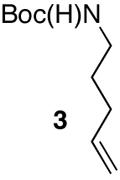
|
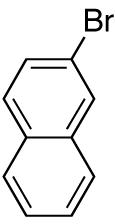
|

|
75 | |
| 2 |
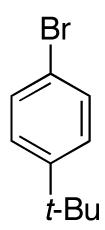
|
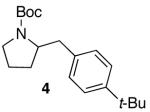
|
82 | ||
| 3 |
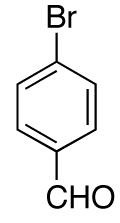
|
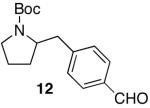
|
78e | ||
| 4 |
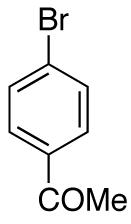
|
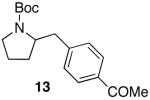
|
76e | ||
| 5 |
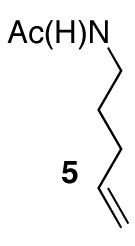
|
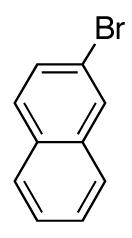
|

|
79 | |
| 6 |
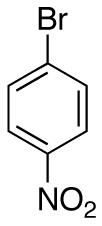
|
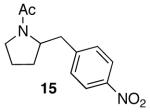
|
76c,e | ||
| 7 |

|
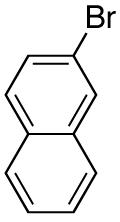
|

|
88 17d |
|
| 8 |
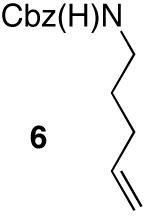
|
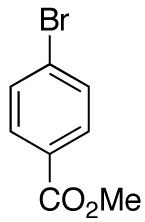
|
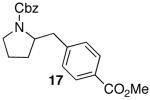
|
— | 88e |
| 9 |
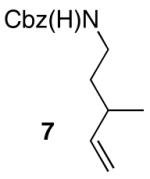
|
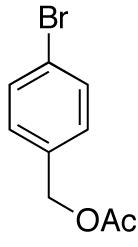
|
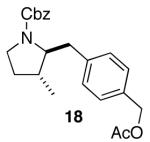
|
12:1 | 80 |
| 10 |
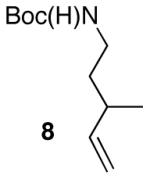
|
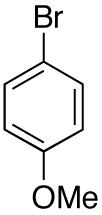
|

|
15:1 | 76 |
| 11 |
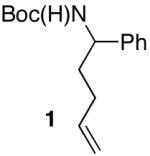
|
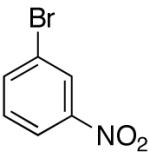
|
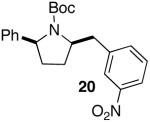
|
>20:1 | 75 |
| 12 |
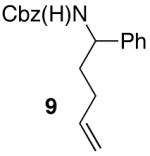
|
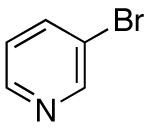
|

|
>20:1 | 74 |
| 13 |
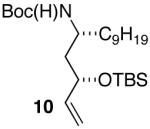
|

|

|
>20:1 | 71 |
| 14 |
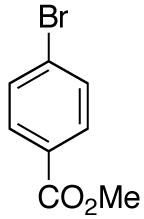
|

|
>20:1 | 73 |
Conditions: 1.0 equiv amine, 1.2 equiv ArBr, 2.3 equiv Cs2CO3, 2 mol % Pd(OAc)2, 4 mol % Dpe-phos, dioxane (0.2–0.25 M), 100 °C.
Yield refers to average isolated yield obtained in two or more experiments.
Dppe used in place of Dpe-phos.
NaOtBu used in place of Cs2CO3.
The reaction wasconducted at 85 °C in DME solvent.
In addition to providing increased tolerance of base-sensitive functional groups, the new reaction conditions also allow the efficient carboamination of substrates bearing Cbz-protecting groups. For example, the Pd-catalyzed coupling of 6 with 2-bromonaphthalene using Cs2CO3 as base provided the desired product 16 in 88% isolated yield (entry 7). In contrast, cleavage of the Cbz-group from the substrate was problematic when reactions were conducted with NaOtBu as base; these conditions provided only a 17% yield of 16.
More complex γ-aminoalkene substrates are also efficiently transformed using the new reaction conditions. As shown in Table 2 (entries 13—14), Pd-catalyzed reactions of 10 with bromobenzene or methyl-4-bromobenzoate proceeded smoothly to provide 22 and 23 with excellent stereoselectivity. Trisubstituted pyrrolidine 22 has been previously employed as an intermediate in the synthesis of the natural product (+)-preussin.2g,9
The high degree of functional group tolerance of this method also allows straightforward access to 1-substituted tetrahydropyrroloisoquinolin-5-ones. As shown in Scheme 1, the Pd-catalyzed reaction of 8 with methyl-2-bromobenzoate afforded pyrrolidine 24 in 73% yield with 14:1 dr. Treatment of this product with trifluoroacetic acid followed by an alkaline workup gave 25 in 95% yield.
Scheme 1.

Stereoselective Synthesis of 25
The main limitations of these new reaction conditions involve transformations of sterically encumbered substrate combinations.10 For example, attempts to convert substrates bearing internal alkenes to pyrrolidines were unsuccessful under these conditions. In addition, the reaction of methyl 2-bromobenzoate with 1, which bears a substituent on C-1 (adjacent to the nitrogen atom), was not effective. However, as noted above, this o-substituted aryl bromide was effectively coupled with the less hindered carbamate 8(Scheme 1).
In addition to greatly expanding the scope of Pd-catalyzed carboamination reactions involving aryl bromide substrates, the use of mildly basic reaction conditions also allows the first Pd-catalyzed carboamination reactions with aryl triflates. Our preliminary efforts to conduct these transformations with the strong base NaOtBu were unsuccessful due to competing cleavage of the trifluoromethanesulfonate ester, which resulted in conversion of the aryl triflate to the corresponding phenol. For example, treatment of 3 with 4-formylphenyl triflate in the presence of catalytic Pd(OAc)2/Dpe-phos and stoichiometric NaOtBu failed to generate the desired pyrrolidine product 12. However, subsequent experiments demonstrated that use of K3PO4 as base provides the desired pyrrolidine 12 in 67% yield (Table 3, entry 1). These conditions are effective with both Boc- and Cbz-protected substrates, and diastereoselectivities are similar to those obtained in related reactions with aryl bromide electrophiles (entries 3-4).
Table 3.
Palladium-Catalyzed Carboamination of Aryl Triflatesa
Conditions: 1.0 equiv amine, 1.2 equiv ArOTf, 2.3 equiv K3PO4, 4 mol % Pd(OAc)2, 8 mol % Dpe-phos, dioxane (0.25 M), 100 °C.
Yield refers to average isolated yield obtained in two or more experiments.
NaOtBu used in place of K3PO4.
In conclusion, we have developed new conditions for palladium-catalyzed carboamination reactions of N-protected γ-aminoalkenes with aryl bromides and triflates. These conditions, which use Cs2CO3 or K3PO4 in place of the strong base NaOtBu, tolerate the presence of a broad array of functional groups, and significantly expand the scope of this method. Applications of these new conditions to the synthesis of complex pyrrolidine alkaloids are currently being pursued.
Supplementary Material
Acknowledgment
The authors thank the NIH-NIGMS (GM071650) for financial support of this work. Additional support was provided by the Camille and Henry Dreyfus Foundation (New Faculty Award, Camille Dreyfus Teacher Scholar Award), Research Corporation (Innovation Award), Eli Lilly, Amgen, and 3M.
Footnotes
Supporting Information Available. Experimental procedures, spectroscopic data, and copies of 1H and 13C NMR spectra for all new compounds reported in the text (65 pages). This material is available free of charge via the Internet at http://pubs.acs.org.
References
- 1 (a).For recent reviews, see: Bellina F, Rossi R. Tetrahedron. 2006;62:7213–7256. Coldham I, Hufton R. Chem. Rev. 2005;105:2765–2810. doi: 10.1021/cr040004c.
- 2 (a).Ney JE, Wolfe JP. Angew. Chem., Int. Ed. 2004;43:3605–3608. doi: 10.1002/anie.200460060. [DOI] [PubMed] [Google Scholar]; (b) Lira R, Wolfe JP. J. Am. Chem. Soc. 2004;126:13906–13907. doi: 10.1021/ja0460920. [DOI] [PubMed] [Google Scholar]; (c) Bertrand MB, Wolfe JP. Tetrahedron. 2005;61:6447–6459. [Google Scholar]; (d) Ney JE, Wolfe JP. J. Am. Chem. Soc. 2005;127:8644–8651. doi: 10.1021/ja0430346. [DOI] [PMC free article] [PubMed] [Google Scholar]; (e) Yang Q, Ney JE, Wolfe JP. Org. Lett. 2005;7:2575–2578. doi: 10.1021/ol050647u. [DOI] [PMC free article] [PubMed] [Google Scholar]; (f) Ney JE, Hay MB, Yang Q, Wolfe JP. Adv. Synth. Catal. 2005;347:1614–1620. doi: 10.1002/adsc.200505172. [DOI] [PMC free article] [PubMed] [Google Scholar]; (g) Bertrand MB, Wolfe JP. Org. Lett. 2006;8:2353–2356. doi: 10.1021/ol0606435. [DOI] [PMC free article] [PubMed] [Google Scholar]
- 3 (a).For a review on other Pd-catalyzed alkene carboamination reactions that afford pyrrolidine products, see: Wolfe JP. Eur. J. Org. Chem. 2007 in press. See also:Harayama H, Abe A, Sakado T, Kimura M, Fugami K, Tanaka S, Tamaru Y. J. Org. Chem. 1997;62:2113–2122. doi: 10.1021/jo961988b. Scarborough CC, Stahl SS. Org. Lett. 2006;8:3251–3254. doi: 10.1021/ol061057e. Sherman ES, Chemler SR, Tan TB, Gerlits O. Org. Lett. 2004;6:1573–1575. doi: 10.1021/ol049702+. Larock RC, Yang H, Weinreb SM, Herr RJ. J. Org. Chem. 1994;59:4172–4178.
- 4.Dpe-phos = bis(2-diphenylphosphinophenyl)ether.
- 5 (a).The use of Cs2CO3 and other weak bases in Pd-catalyzed N-arylation reactions of amines with aryl halides has been reported. For reviews, see: Muci AR, Buchwald SL. Top. Curr. Chem. 2002;219:131–209. Hartwig JF. In: Modern Arene Chemistry. Astruc D, editor. Wiley, VCH; Weinheim: 2002. pp. 107–168. Schlummer B, Scholz U. Adv. Synth. Catal. 2004;346:1599–1626.
- 6.Lower yields were obtained with other weak bases including K2CO3 and Et3N.
- 7.In some cases use of DME as solvent provided comparable results to those obtained with dioxane (Table 2, entries 3, 4, 6, and 8.)
- 8 a).The differences in reactivity between Pd2(dba)3 and Pd(OAc)2 are not fully understood, but may result from coordination of dba (dibenzylideneacetone) to the metal at key stages in the catalytic cycle, or through the formation of dba-ligated complexes that lie outside of the catalytic cycle. Dba has previously been demonstrated to have a large impact on the rates of Pd-catalyzed or mediated process. For lead references, see: Shekhar S, Ryberg P, Hartwig JF, Mathew JS, Blackmond DG, Strieter ER, Buchwald SL. J. Am. Chem. Soc. 2006;128:3584–3591. doi: 10.1021/ja045533c. Amatore C, Broeker G, Jutand A, Khalil F. J. Am. Chem. Soc. 1997;119:5176–5185.
- 9 (a).Huang P-Q, Wu T—J, Ruan Y—P. Org. Lett. 2003;5:4341–4344. doi: 10.1021/ol035617a. [DOI] [PubMed] [Google Scholar]; (b) Kadota I, Saya S, Yamamoto Y. Heterocycles. 1997;46:335–348. [Google Scholar]; (c) Yoda H, Yamazaki H, Takabe K. Tetrahedron: Asymmetry. 1996;7:373–374. [Google Scholar]
- 10.These conditions were also less effective for carboamination reactions of γ-(N-arylamino)alkenes; the desired N-arylpyrrolidine products were obtained in low to moderate yield (35—55%).
Associated Data
This section collects any data citations, data availability statements, or supplementary materials included in this article.



